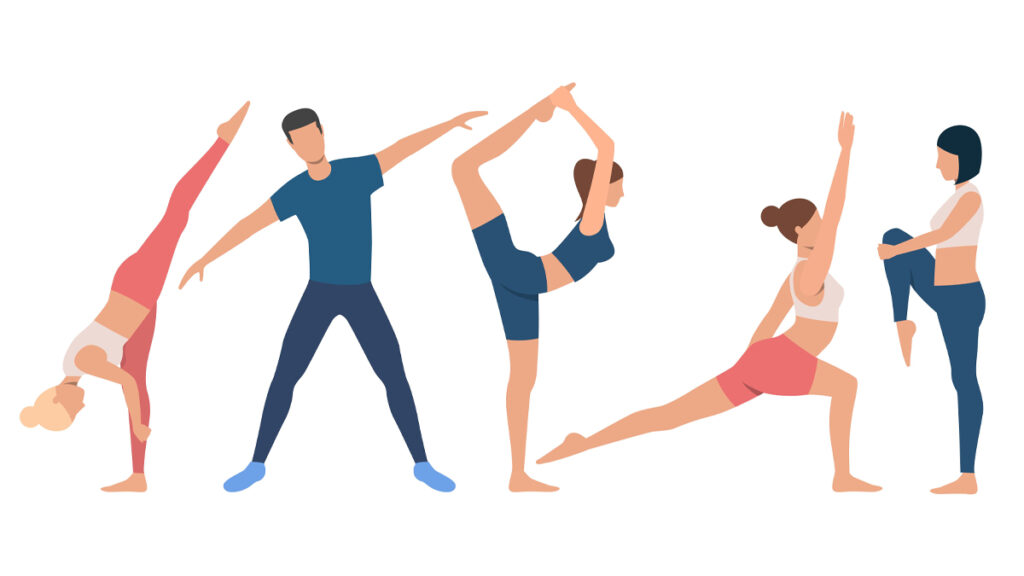A good warm-up is essential, and dynamic stretches are often recommended to prepare your body for exercise. So, what are dynamic stretches, and why should we care about them? Let’s find out more about dynamic stretching and why it is valuable.

Why Dynamic Stretching?
Dynamic stretching is a vital part of exercise, as it ensures that your body is prepared for physical activity and improves overall performance while reducing the risk of injuries. They prepare your muscles, ligaments, and soft tissues for your workout, enhancing your performance and reducing the risk of injuries. These stretches include trunk twists, walking lunges, and leg swings against a wall. Whether you’re a serious athlete or simply aiming to maintain your fitness, stretching is crucial. It increases flexibility and range of motion while decreasing stiffness in muscles and ligaments, thereby improving performance and reducing the risk of injury.
In this Te Mend article, we will delve into the workings of dynamic stretching, explore its advantages, and provide examples for various workout routines. We’ll also share safety tips to ensure you stretch effectively and safely.
Types of Stretching: Static and Dynamic
In the world of stretching, we have two players: static and dynamic. It is important to understand how both work and why they are important to us. These stretching’s are two distinct methods for preparing your body for physical activity. These stretches have unique benefits for our bodies.
Static Stretching:
Static stretching is when you gently stretch a particular muscle and then hold that stretch for a little while. For example, if you reach your arm behind your back to stretch your triceps (the muscle on the back of your upper arm), that’s a static stretch. You should keep the stretch position for about 10 seconds to a minute, or even longer if that’s what you’re aiming for.
This type of stretching is excellent for increasing the length of a muscle that spans across the joints. It is most effective when performed after a workout to help relax your body and return it to a more rested state.
Dynamic Stretching:
Dynamic stretching, on the other hand, focuses on movement. It involves controlled and purposeful movements of muscles and joints throughout their full range of motion. Dynamic stretches are typically a part of your warm-up routine before a workout or physical activity.
Dynamic stretching helps prepare your muscles and joints for the upcoming activity. It also enhances blood flow, preparing your body for action without significantly increasing your heart rate. These stretches mimic the movements you will perform during your workout, helping your body become accustomed to the upcoming exercise. These stretches are also beneficial for activities that require flexible joints, such as sports or prolonged workouts. They increase blood circulation and warm up your body, preparing you for action.
Research shows that dynamic stretching can enhance your range of motion, which is crucial for activities involving power, sprinting, jumping, and muscle force. Therefore, dynamic stretches can be a valuable addition to your warm-up routine, helping you perform at your best.
Benefit of Dynamic Stretching
Dynamic stretching is a type of stretching that actively moves your muscles and joints through their full range of motion in a controlled manner. Unlike static stretching, which involves holding a position, dynamic stretching involves movement. This type of stretching offers numerous benefits for individuals of all fitness levels and activities. Here are the main advantages of dynamic stretching:
Improved Range of Motion: Dynamic stretching helps increase joint flexibility and range of motion. It involves moving your limbs and joints through their full range of motion, which gradually expands your flexibility. This increased flexibility can enhance athletic performance and reduce the risk of injury.
Enhanced Athletic Performance: Athletes often incorporate dynamic stretching into their warm-up routine. It can help activate the muscles, increase blood flow, and prepare the body for more intense physical activity. Dynamic stretching also helps improve neuromuscular coordination, making movements more efficient and precise.
Injury Prevention: Dynamic stretching can reduce the risk of injury by gradually preparing the body for physical activity. It helps to increase blood flow to the muscles, making them more flexible and less prone to strains and tears. Dynamic stretching helps ensure that the body is ready for the demands of exercise by moving the joints and muscles through their full range of motion.
RELATED: Warning signs and Home Remedies for Dengue Fever
Muscle Activation: Dynamic stretching engages various muscle groups as they contract and lengthen during the stretches. This activation primes the muscles for action, making them more responsive and prepared to perform during your workout or activity.
Improved Circulation: The dynamic movements involved in dynamic stretching stimulate blood flow throughout the body. This increased circulation can help reduce muscle stiffness and enhance oxygen and nutrient delivery to the muscles, which is crucial for overall performance and recovery.
Enhanced Coordination and Balance: Dynamic stretching can improve your body’s coordination and balance by challenging the nervous system to communicate with the muscles in a more dynamic and intricate manner. This can be especially advantageous for activities that demand agility and precise movements, such as sports and dance.
Time Efficiency: Dynamic stretching is often quicker and more time-efficient than static stretching. While dynamic stretching effectively prepares the body for physical activity, it does not require the same duration of holding positions as static stretching does.
Customizable: Dynamic stretching can be customized to suit the specific requirements of your activity. Different stretches and movements can be selected to specifically target the muscles and joints that are most relevant to your chosen sport or exercise routine.
10 Dynamic Stretching Exercises
The below mentioned dynamic stretches are best for warming up your body. These stretches are ideal for a full body warm up, so you should try them before your workout.
- Head rolls and shoulder rolls
- Arm circles and swimmer’s stretch
- Helicopter/ Trunk rolls
- Windmills/Squats
- Walking lunge
- Spider-Man lunge
- Side shuffles
- Walking hamstring toe touches
- Dynamic calf stretch
- Ankle rolls
- Leg swings
Safety tips for Dynamic Stretching
Safety is important when performing dynamic stretching exercises. Below are some tips to keep in mind when starting a stretching routine.
Start Gradually: Begin with slow and controlled movements to warm up your muscles and joints.
Proper Form: Ensure correct posture and technique to avoid strain or injury.
Tailor to Your Activity: Choose dynamic stretches that align with your planned workout or sport.
Avoid Bouncing: Do not use jerky or forceful movements, as they can strain your muscles.
Stay in Control: Maintain balance and coordination during dynamic stretches.
Warm-Up First: Dynamic stretching is most effective after a light aerobic warm-up.
Body and Joint Pain: If you experience pain in your body and joints, refrain from doing stretching exercises.
Progress Gradually: Increase the intensity and range of motion gradually over time.
Stay Hydrated: Dehydration can lead to muscle cramps, so make sure to drink enough water.
Frequently Asked Question
What is the main purpose of dynamic stretching?
Dynamic stretching aims to prepare your body for physical activity by engaging muscles and joints in a controlled range of motion. It enhances blood flow, increases flexibility, and readies your body for action, making it especially valuable for activities requiring limber joints and prolonged physical effort, such as sports and workouts.
What is the reason why stretching is important?
Stretching is vital because it increases flexibility, improves the range of motion, and reduces stiffness in muscles and ligaments. This not only enhances performance but also lowers the risk of injuries during physical activities, making it an essential part of any workout routine or sport preparation.
Is dynamic stretching safe?
Yes, dynamic stretching is safe when done correctly. It involves controlled movements that prepare your body for physical activity. When tailored to the specific activity, dynamic stretches can improve blood flow and flexibility while minimizing the risk of injury, making them a recommended part of a warm-up routine.
RELATED: Is Buckwheat Flour (Kuttu Atta) Good for Weight Loss?
How long to do dynamic stretches?
The duration for dynamic stretches can vary, but generally, 5 to 10 minutes of dynamic stretching is sufficient for a warm-up before physical activity. The focus is on engaging the muscles and joints through a full range of motion rather than holding a static position, so it’s about quality and not necessarily quantity.
How many repetitions of a stretch should you do during a stretching session?
The number of repetitions during a stretching session can vary, but a common recommendation is to perform each stretch 2-4 times, holding for 15-30 seconds per repetition. This allows for a gradual increase in flexibility without overstretching the muscles. The specific repetitions can be adjusted based on individual needs and goals.
Which stretching technique do experts recommend for general fitness?
For general fitness, experts recommend dynamic stretching as a pre-workout routine. Dynamic stretches involve active movements that prepare muscles and joints for exercise by mimicking the upcoming activity. They promote flexibility and enhance performance, making them a preferred choice for warming up before a workout and improving overall fitness.
“Good news! Te Mend is now available on WhatsApp & Telegram Channels. Subscribe today through the link and stay updated with the latest news!” Whatsapp & Telegram




